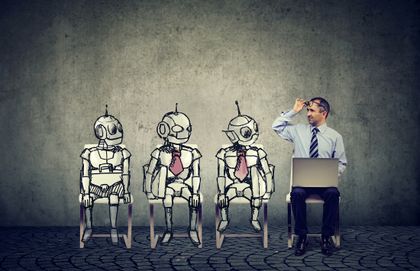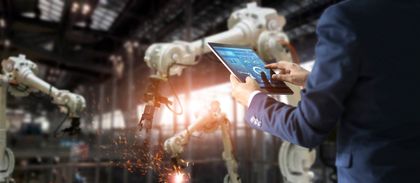Industry 4.0 And The Future Of Training Workers
Corey Bleich
🍿 4 min. read
Industry 4.0 describes the newest revolution in manufacturing and production, but with a twist. Knowing how to train employees for this next generation of work is critical. Here’s what industry 4.0 means for the future of training workers in whatever industry you're in.
What is industry 4.0?
While the first three industrial revolutions dealt with innovations in machines, production, and electronics (respectively), industry 4.0 technologies center on, among other things, the following:
- The internet of things
- Smart cities
- Artificial intelligence
- Cloud and cognitive computing
Industry 4.0 builds on the work of industry 3.0, where computerization was introduced and refined. Add smart systems, wireless connectivity, and virtual/augmented reality, and industry 4.0 is the result.
Increased smart automation means that machines driven by wireless connectivity are better able to adapt their workflow responsively. Machines are connected and work together. They are revolutionizing modern production and life in much the same way as the assembly line did in the early 20th century.

The impact on the workforce
People have been concerned about “robots taking jobs” since the first robot was built. And in some ways, they aren’t necessarily wrong to be concerned. The Hays Global Skills Index noted that jobs in the middle of the skills spectrum were disappearing. Combine this with a study by the McKinsey Global Institute that found that employers could save an estimated $15 trillion in wages by 2030, and a little anxiety seems understandable.
But there is good news.
While some jobs will eventually be phased out, others will rise in their place, exceeding what’s lost. These jobs will be new and evolving as this revolution continues.
Workers will need to be open to re-training, upskilling, and shifting across their industries to new roles with the coming of industry 4.0.
Trends across the globe
Although we have spent the last several decades connecting companies across the globe, one trend in industry 4.0 is increasing localization. This means that factories and manufacturing are moving closer to the people they serve. This movement presents a unique opportunity to design smart factories that dovetail nicely with the demands of industry 4.0 technologies.
Globally, industry 4.0 also means an increase in demands for cyber security plus transparency and privacy. Demand is also projected to increase for:
- Industrial robots
- Cloud computing
- 3D printing
- Extended reality
Industry 4.0 is permanently changing the way we work. Training has to change with it.
How do you train employees for industry 4.0?
Training employees for industry 4.0 requires a balance between honoring the skillsets employees already have while adding to their abilities. This can be done with a couple of different approaches.
Upskill your employees
Just because the way we build things and connect people is changing doesn’t mean you need to throw out the old employees to make way for new. In fact, upskilling employees has several distinct advantages over hiring a brand-new slate of workers.
Veteran employees:
- Know your company culture
- Have a built-in understanding of your products and services
- May be more committed to your company
Upskilling also reduces the digital skills gap and fosters a better connection between employees and technology. This is critical as industry 4.0 moves forward (and looks towards the next revolution).
Modify your training methods
Augmented reality and in-the-flow-of-work digital performance support: these are just two of the training methods that can help you deliver better training to employees navigating industry 4.0 technologies. They better resemble the systems that workers will need to work within, right where they work, making these training methods more valuable to employees long-term.
Train for both hard and soft skills
Soft skills may have been just a buzzword at the turn of the 21st century, but these days if they aren’t in place, it’s hard to move forward.
Soft skills include things like:
- Creativity
- Persuasion
- Collaboration
- Adaptability
- Emotional intelligence
Soft skills allow employees to rise to the challenges of changing career paths and increased hard skills training requirements. Adaptability means being able to roll with whatever comes your way. It’s a critical piece of industry 4.0 success.
How to meet workers where they are
Training employees for industry 4.0 means meeting them where they are. It takes an assets-based approach to retraining that recognizes the positives that people are already bringing to the table while investing in their new skills development.
Some of the 4.0 training trends are simply more complex iterations of training we’ve seen before. These include the following.
Augmented reality (AR) training
A Harvard Business Review paper found in 2017 that augmented reality was already improving worker performance in manufacturing.
Virtual reality (VR) training
VR training can help reduce production costs while maintaining quality standards and increasing production. With global shortages and surging demand, this type of training is critical.
Digital performance support
Mobile-first digital performance support means employees can access industry 4.0 technology exactly when they need it.
On-the-job training
On-the-job training gets employees to work as they learn. Use an additive process whereby employees gradually learn the layered skills they need as they work.
This type of training may also result in less downtime as employees shift to the demands of industry 4.0 technologies.
Checklists
Digital checklists help employees to learn systems and processes for a particular job or at a particular location.
Microlearning
Microlearning uses mobile devices to deliver brief training and information that is designed to help employees learn new skills as they need them. Designed to deliver information in the way the brain learns best, these tools provide information exactly when and where employees need it.
Get started
EdgePoint Learning can help you make sense of the new training landscape. Industry 4.0 places increasing demands on employers as they adapt their old training materials to a new way of thinking.
Get in touch and let’s work on it together.
